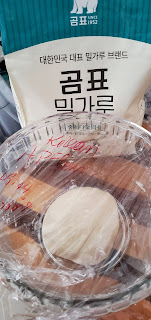I was trying to make CHAGIO - Vietnamese fried spring rolls. We made it so easily when we lived in S Viet-Nam, but it seems so formidable trying to make it now. The wrappers seem to be different. The first couple of times I tried, the wrapper looked like a burnt plastic. They looked scary. I don't think they really used the rice and tapioca flour. I think they are foreign chemical - plastic. I gave it a year of rest. I retried it this time buying the wrapper that says for the fried spring roll. Yes, you could easily make them with the Chinese spring roll wrappers, but it's just not the same. Just for the crab Cha Gio served at one of the hole in the wall eatery in Cholon maybe a good reason to visit S Viet-Nam one of these days.
The results - I like the square Banh Trang ChaGio wrapper. Does it really matter?
pre-soaked rice vermicelli in hot boiling water.
Stir fry them all briefly. Add potato starch roux to coagulate them. There should be very little liquid.
All the filling ingredients are pre-cooked.
The round one's texture looks so plastic.Square ones look more 'home made'?
To keep the seems to split open during frying, it maybe a good idea to use a cornstarch roux, paste to dab all around the edge. Otherwise, during frying, you will be holding onto the spring roll's seam closed until the outer skin is quite browned.
Let them sit to dry. It is also important that the wrapper skin is quite dry before frying. to keep them from opening up.
To fry, do not let go of the tongue or the chop stick holding the seam closed until quite browned.
The result - I like the square ChaGio wrapper. The texture looks more real ingredients than the round wrapper. It's not a very good reason, but the round wrapper seems so plastic like when fried. Maybe that's the way tapioca behaves in heat. I need t do it again. Air dry the rolls longer. than, fry gently maybe better. Serve with vinegar, lemon juice, chili flakes or other recipes you find in the Internet with lime juice and nuoc mum - fish sauce and chili, etc.






























































